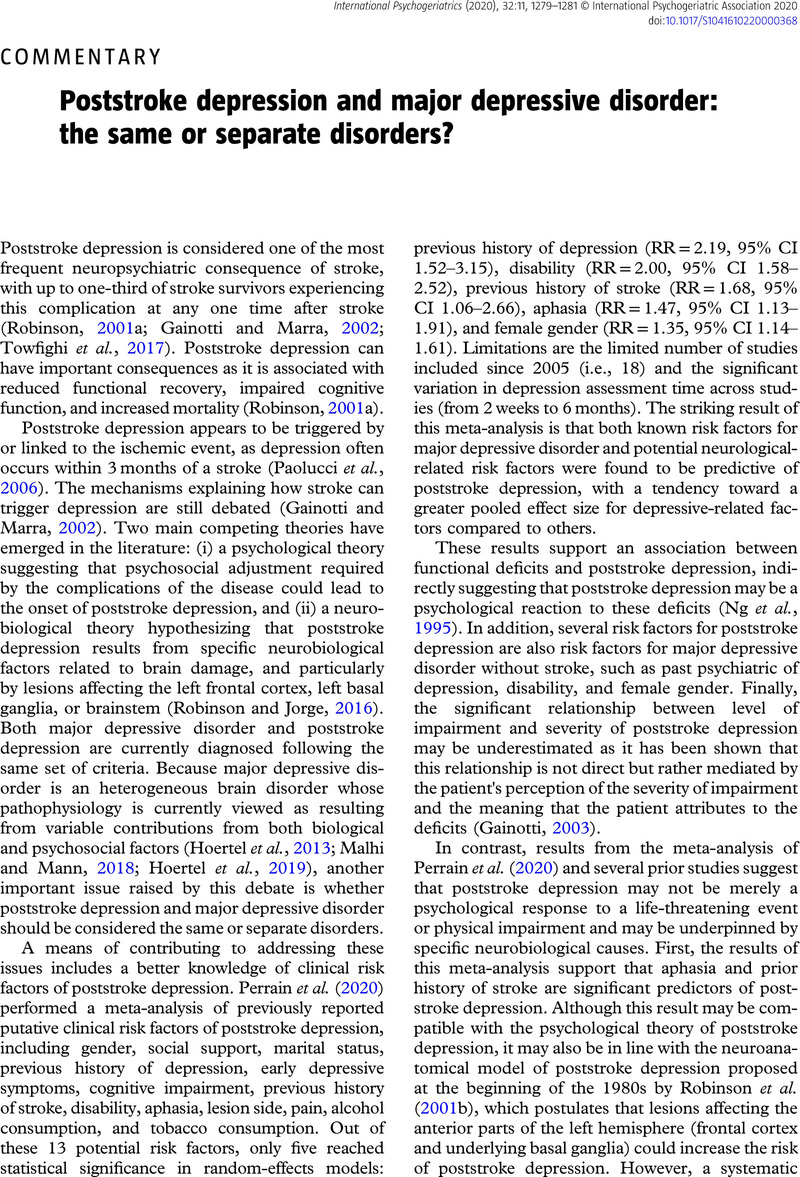No CrossRef data available.
Article contents
Poststroke depression and major depressive disorder: the same or separate disorders?
Published online by Cambridge University Press: 09 December 2020
Abstract
An abstract is not available for this content so a preview has been provided. Please use the Get access link above for information on how to access this content.

- Type
- Commentary
- Information
- International Psychogeriatrics , Volume 32 , Special Issue 11: Issue Theme: Risk versus Protective Factors for Decline versus Well-Being , November 2020 , pp. 1279 - 1281
- Copyright
- © International Psychogeriatric Association 2020
References
Albert, P. R. (2018). Is poststroke depression the same as major depression? Journal of Psychiatry & Neuroscience, 43, 76–78.CrossRefGoogle ScholarPubMed
Alexopoulos, G. S., Meyers, B. S., Young, R. C., Kakuma, T., Silbersweig, D. and Charlson, M. (1997). Clinically defined vascular depression. The American Journal of Psychiatry, 154, 562–565.Google ScholarPubMed
Altieri, M., et al. (2012). Depression after minor stroke: prevalence and predictors. European Journal of Neurology, 19, 517–521.CrossRefGoogle ScholarPubMed
Carson, A. J., et al. (2000). Depression after stroke and lesion location: a systematic review. Lancet, 356, 122–126.CrossRefGoogle ScholarPubMed
Flaster, M., Sharma, A. and Rao, M. (2013). Poststroke depression: a review emphasizing the role of prophylactic treatment and synergy with treatment for motor recovery. Top Stroke Rehabil, 20, 139–150.CrossRefGoogle ScholarPubMed
Gainotti, G. (2003). Assessment and treatment of emotional disorders. Handbook of Clinical Neuropsychology, 368–386.Google Scholar
Gainotti, G. and Marra, C. (2002). Determinants and consequences of post-stroke depression. Current Opinion in Neurology, 15, 85–89.CrossRefGoogle ScholarPubMed
Hoertel, N., et al. (2013). Why does the lifetime prevalence of major depressive disorder in the elderly appear to be lower than in younger adults? Results from a national representative sample. Journal of Affective Disorders, 149, 160–165.CrossRefGoogle ScholarPubMed
Hoertel, N., et al. (2019). Subsyndromal and syndromal depressive symptoms among older adults with schizophrenia spectrum disorder: prevalence and associated factors in a multicenter study. Journal of Affective Disorders, 251,
60–70.CrossRefGoogle ScholarPubMed
Loubinoux, I., et al. (2012). Post-stroke depression: mechanisms, translation and therapy. Journal of Cellular and Molecular Medicine, 16, 1961–1969.CrossRefGoogle ScholarPubMed
Malhi, G. S. and Mann, J. J. (2018). Depression. Lancet, 392, 2299–2312.CrossRefGoogle ScholarPubMed
Ng, K. C., Chan, K. L. and Straughan, P. T. (1995).
A study of post-stroke depression in a rehabilitative center. Acta Psychiatrica Scandinavica, 92, 75–79.CrossRefGoogle Scholar
Noonan, K., Carey, L. M. and Crewther, S. G. (2013). Meta-analyses indicate associations between neuroendocrine activation, deactivation in neurotrophic and neuroimaging markers in depression after stroke. Journal of Stroke and Cerebrovascular Diseases: The Official Journal of National Stroke Association, 22,
e124–e135.CrossRefGoogle ScholarPubMed
Paolucci, S., Gandolfo, C., Provinciali, L., Torta, R., Toso, V. and Group, D. S. (2006). The Italian multicenter observational study on post-stroke depression (DESTRO). Journal of Neurology, 253,
556–562.CrossRefGoogle Scholar
Perrain, R., Mekaoui, L., Calvet, D., Mas, J.-L. and Gorwood, P. (2020). A meta-analysis of post-stroke depression risk factors comparing depressive-related factors versus others. International Psychogeriatrics, 32, 1331–1344.CrossRefGoogle ScholarPubMed
Robinson, R. G. (2001a). Dementia and poststroke major depression. In: K. Miyoshi, C. M. Shapiro, M. Gaviria, and Y. Morita (Eds.), Contemporary Neuropsychiatry (pp 128–134). New York: Springer.CrossRefGoogle Scholar
Robinson, R. G. (2001b). The neuropsychiatry of stroke. In: K. Miyoshi, C. M. Shapiro, M. Gaviria, and Y. Morita (Eds.), Contemporary Neuropsychiatry (pp 116–127).
New York: Springer.CrossRefGoogle Scholar
Robinson, R. G. and Jorge, R. E. (2016). Post-stroke depression: a review. The American Journal of Psychiatry, 173, 221–231.CrossRefGoogle ScholarPubMed
Starkstein, S. E., Fedoroff, J. P., Price, T. R., Leiguarda, R. and Robinson, R. G. (1992). Anosognosia in patients with cerebrovascular lesions. A study of causative factors. Stroke, 23, 1446–1453.CrossRefGoogle ScholarPubMed
Towfighi, A., et al. (2017). Poststroke depression: a scientific statement for healthcare professionals from the American Heart Association/American Stroke Association. Stroke, 48, e30–e43.CrossRefGoogle ScholarPubMed




